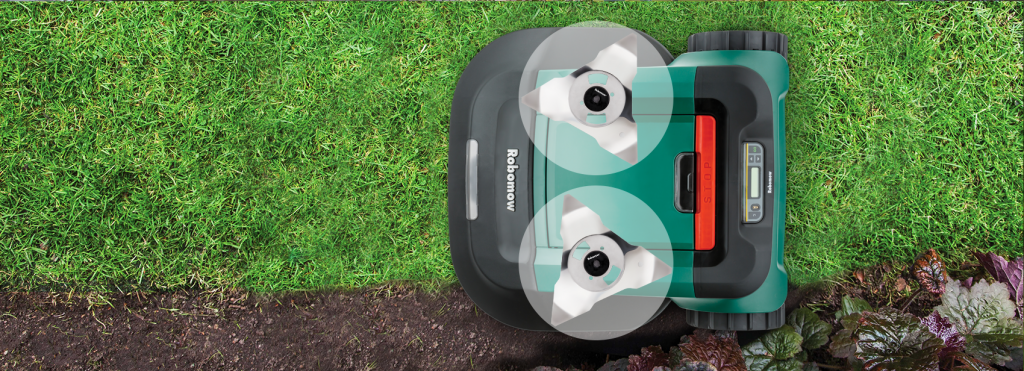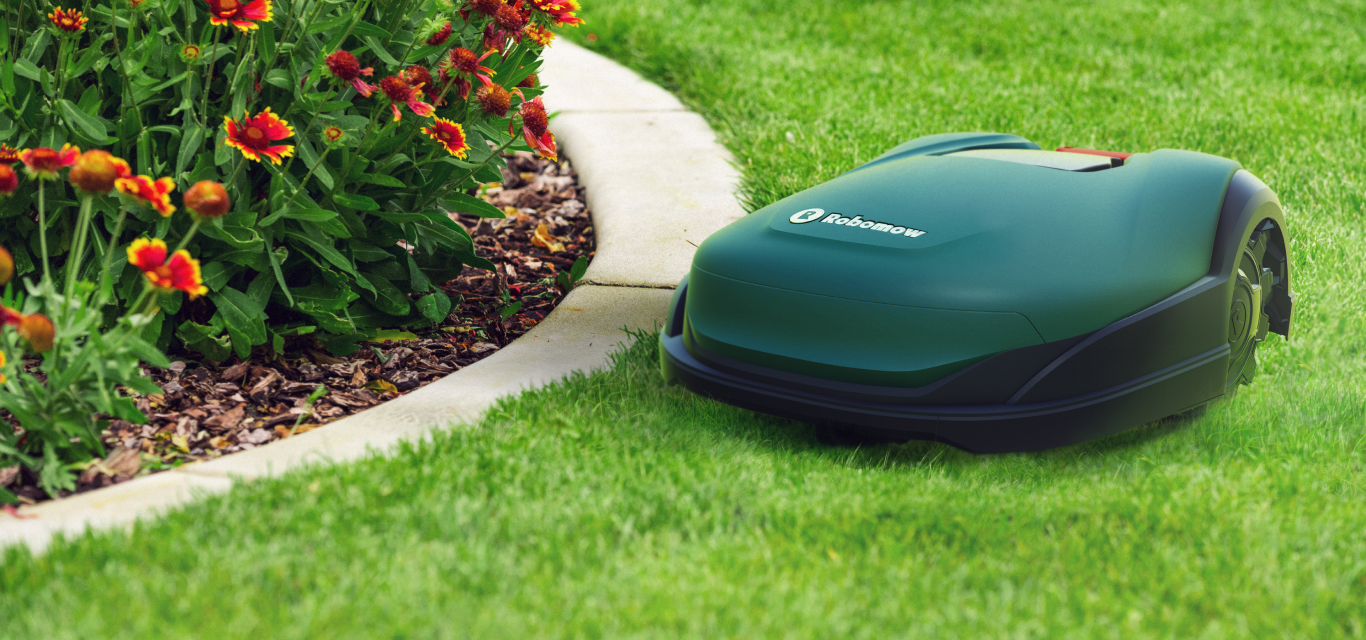How cleanly does a robotic lawnmower mow the lawn edge
28.10.2022With the acquisition of a robotic mower, garden owners actually hope to relinquish all power to their new garden helper. Unfortunately, lawn edges quickly become a nuisance when a small strip remains that needs to be trimmed manually because the robot simply cannot reach it. Luckily, there are methods to help you also mow the lawn edge.
A robotic mower helps keep the time spent on lawn care to a minimum. Not only are you free from mowing the lawn itself, but maintenance work is also normally less than with a classic gasoline mower. With that being said, pesky lawn edges may require manual reworking with a lawn trimmer or shears. After all, the overall appearance is not very neat if blades of grass sprout uncontrollably around the edges of the lawn. Not every robotic lawnmower really cuts the edges cleanly. This is often not possible for technical reasons alone. But never fear, there are ways to help minimize retouching.
Why do robotic lawnmowers leave an edge?
The fact that robotic mowers do not just mow lawns to the very edge is primarily due to the safety precautions offered by the device. Razor-sharp blades are well protected under the device and designed to stop automatically when lifted to avoid any possible contact. If blades protruded too far, they could pose a risk of injury.
So the width of the edge ultimately depends on the distance between the blades and the housing. If the blades are centered, this is quite large at 10-20 centimeters. In models with an edge-cutting function, the edge may be considerably narrower at approximately 5 centimeters. That sounds like a lot at first, but it's no different from classic lawn mowers. They can also leave a small edge, which requires retouching.
Robotic mowers with edge-cutting function
Most robotic lawnmowers do not reach the edges due to their design, as the blade is centered underneath the device. There is a gap between the blade and the housing, which is especially noticeable when the robot drives along a wall. A strip of about 10-20 centimeters remains. Accordingly, the strip may increase with the size of the robot and the distance of the perimeter wire to the edge.
In the case of a robotic mower with edge-cutting function, the blade does not sit in the middle, but laterally under the device and even protrudes beyond the wheelbase. Still, there is a small distance to the outer edge of the housing. Nevertheless, this is limited to a much smaller width of about 6 centimeters so that the lawn edge is cut quite cleanly. The robotic lawnmower plans its mowing in such a way that it runs along the edges with the blade side to help keep the edge as small as possible.
A clean lawn edge can be achieved by laying a row of stones along walls so that the lawn does not grow right up against the wall, but leaves a small passable strip for the robotic lawnmower.
The correct laying of the boundary wire is important
For robotic lawnmowers with an edge-cutting function, it is particularly important to make sure the boundary wire is laid accurately. If you lay the wire too far inward, it will not be possible for the blade to reach the lawn edge. The ideal distance of the perimeter wire to lawn edges, walls or fences can be found in the manufacturer's manual. Some models also have a ruler to help facilitate installation. These indications should definitely be followed, because the boundary wire is by no means the outer edge of the cutting width. If the wire is laid directly at the edge, the robotic lawnmower will go a little beyond it: in some models even as much as 30 cm.
If there are thoroughfares that are driven over, there is no need for a demarcation by the wire. The robot simply drives over them and mows the edges automatically. However, if the path represents the outer edge of the lawn, place the wire close to the path so that the robotic lawnmower cleanly takes the edge with it.
Caution should be exercised, however, if lawn edges are eliminated from flower beds. If the perimeter wire is too close to the edge, the robotic lawnmower risks slipping and getting stuck in the edge. The same applies along bodies of water or walls, to which a somewhat greater distance should always be maintained when laying the wire.
Guideline values for the perimeter wire distance for Robomow robotic lawnmowers
The distance of the perimeter wire from obstacles and beds differs depending on the manufacturer as well as from model to model. Almost all Robomow models have an edge cutting function, so the distance is comparatively small for traversable boundaries.
Model - Distance to fixed obstacle - Distance at ground level boundary
Lawn edging stones for the perfect edge cut
Not all robotic lawnmowers have a practical edge cutting function. Regardless, with a little ingenuity, lawn edges can be cut ideally even with models where the blade is centered. This will require either the appropriate advanced planning in your garden design or some reworking.
To do this, border the lawn and flower beds with lawn edging stones. These should be level with the ground and thus passable for the robotic lawnmower. Depending on the robotic lawnmower, a width of approx. 10 to 24 cm is recommended. It is also important to know whether the stone is adjacent to a wall or borders a bed behind it.
To prevent the lawn from growing into the bed, lay the lawn edging stones in two rows next to each other and stagger the joints in each case.
Next, lay the boundary wire as close as possible to the stones so that the robot uses one of the wheels to drive over the stones while the centrally positioned blade reaches the lawn edge.
Robotic lawnmower with three wheels
Some robotic lawnmowers have only three wheels instead of four. The front axle is substituted by a centrally placed wheel to help increase maneuverability but at the same time can make the devices more susceptible to getting stuck in soft ground. Accordingly, it is recommended to place lawn edging stones in such a way that the robotic lawnmower does not drive with the front wheel extending beyond the boundary.
Types of lawn edging stones
Lawn edging stones are available in a wide variety of designs and sizes. Which stone is suitable is first a question of personal taste. Secondly, the required width for the robotic mower should be included in your decision so that the lawn edge is cut as cleanly as possible. Possible stone types that would be appropriate for a robotic mower are:
- Dovetail stones
- Granite stones (the familiar cobblestone)
- Concrete sidewalk slabs
- Rectangular concrete paving
Of course, combinations of the stone types are also possible, which sometimes results in exciting designs.
Alternative bed edgings - not always suitable for robotic mowers
Alternatives to concrete edging stones are also bed edgings made of wood, metal or plastic or simply leaving the front edge of the bed free of vegetation so that the robot can use soil or humus as a navigation surface. In this case, however, regular edge trimming is necessary to avoid having your lawn grow into the bed. Although these bed edgings protect plants from undesirable intrusion of the robotic lawnmower, they are also not passable making reworking necessary. Metal bed edgings in particular also pose the risk of interfering with the signal of the robotic lawnmower.
Bed edging for robotic lawnmowers with grass sensors
For robotic mowers that use sensors instead of a perimeter wire, bed edgings are essential to provide a clear contrast between the lawn and the beds or to simply create a natural barrier that the robot cannot cross. Level lawn stones are therefore less suitable as a boundary. This means that manual reworking with a lawn trimmer is the only option.
MANUAL RETOUCHING WITH A LAWN TRIMMER
If you do not want to convert your garden, nor do you have a robotic lawnmower with an edge-cutting function, you can manually retouch the lawn with a lawn trimmer or (preferably battery-powered) lawn shears. Both are not particularly time-consuming or strenuous. Furthermore, it may be necessary to buy a second device for your lawn care. This may require more space for storage and additional costs.
Of course, which device is best suited depends on the size of your garden and the length of the lawn edges. For smaller stretches, manual lawn shears may even suffice. However, for larger gardens, a battery-powered lawn trimmer makes the job much easier. Maximum flexibility is offered by models with a swivelling cutting head.
FURTHER CRITERIA OF THE ROBOTIC LAWNMOWER FOR CLEAN LAWN EDGES
An edge cutting function is one thing. The other is a robotic lawnmower that can achieve an overall optimalt cut pattern.
- The most important criterion is sharp blades that really cut the lawn cleanly. The result of dull blades are frayed grass tips that tend to turn brown, which can eventually, cause your lawn to no longer look green, lush and healthy.
- A pendulum-mounted mowing deck is also helpful, as it is designed to provide a uniform cut even if the terrain is not completely level.
- In order to have a strong grip, especially on bumpy terrain or slopes, wheels with particularly good traction are recommended.
Robotic lawnmowers with an edge-cutting function mow edges cleanly to within a few centimeters but also reach their limits with vegetation that comes right up to walls and fences. To help avoid any kind of retouching, it is therefore advisable to edge the lawn with a margin of about 6 centimeters to the outermost edges. This will give you time to enjoy your manicured garden without still having to resort to the lawn trimmer.
Products
Buy a Robomow
Robomow owner
About us
Sales & Support


